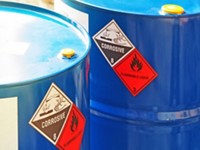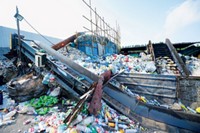Advertisement
Grab your lab coat. Let's get started
Welcome!
Welcome!
Create an account below to get 6 C&EN articles per month, receive newsletters and more - all free.
It seems this is your first time logging in online. Please enter the following information to continue.
As an ACS member you automatically get access to this site. All we need is few more details to create your reading experience.
Not you? Sign in with a different account.
Not you? Sign in with a different account.
ERROR 1
ERROR 1
ERROR 2
ERROR 2
ERROR 2
ERROR 2
ERROR 2
Password and Confirm password must match.
If you have an ACS member number, please enter it here so we can link this account to your membership. (optional)
ERROR 2
ACS values your privacy. By submitting your information, you are gaining access to C&EN and subscribing to our weekly newsletter. We use the information you provide to make your reading experience better, and we will never sell your data to third party members.
Environment
A Tsunami Of Electronic Waste
No high-tech solutions for the detritus of the Information Revolution
by Jeff Johnson
May 26, 2008
| A version of this story appeared in
Volume 86, Issue 21

ON A SUNNY Saturday in late April, some 4,000 cars and trucks crawled up 16th Street in northwest Washington, D.C., ferrying loads of electronic and other wastes to drop off at the city's semiannual hazardous waste collection event. The lines stretched for miles and tempers grew short as residents inched along, waiting for more than three hours to leave their junk in a big parking lot. Finally, as they got to the actual drop-off spot, residents drove through 5-foot-high canyons of old televisions, computers, printers, fax machines, Game Boys, iPods, you name it—the final resting place for the fruit of the high-tech revolution.
The District of Columbia has had these collections before, but the recent event was a record, says Nancee Lyons, a spokeswoman with the D.C. Department of Public Works. "We didn't expect anywhere near this turnout," she says. A year ago at an identical event, half the number of people turned out, and the District collected 40 tons' worth of electronic waste. This year likely doubled that amount.
The collected material went from the District straight to prison, specifically to Lewisburg Federal Penitentiary, in Lewisburg, Pa., where it is considered a donation from the D.C. government. There, inmates will test the material to see what works and what can be economically refurbished for resale. Most likely, however, little of the material will be worth rebuilding, and most of it will be stripped down by hand, shredded, and recycled to recover various metals and other materials. What's left will go to a landfill or an incinerator with other waste. Lewisburg is one of seven federal prisons that make up UNICOR's e-waste recycling program. UNICOR, a government-created corporation, is part of the Federal Bureau of Prisons.
Although Americans might blanch if inmates in Chinese prisons disassembled their televisions, there appears to be little problem if U.S. prisoners do it. Indeed, UNICOR might be the one of the better e-waste recycling operations in the U.S. or the world, a fact that says volumes about the back end of the information age.
E-waste recycling is a labor-intensive operation that doesn't pay unless the components are usable and the recovered material is of high value, such as gold, copper, and other sellable metals. This is often the case for newer electronic equipment but not for older equipment. However, just physically getting the stuff a recycler wants can be tough.
The sector consists of small businesses, and even the exact number of e-waste recyclers is unclear. The International Association of Electronics Recyclers places the number at around 500 in the U.S. Eric Harris, director of governmental and international affairs with the Institute of Scrap Recycling Industries, said about 300 of his institute's member companies are e-waste scrap recyclers. It is the fastest growing recycling sector, he added.
Speaking at a hearing of the House Science & Technology Committee on April 30, Harris said e-waste recycling covers a multitude of different products, from televisions and computers to toasters and hair dryers. "Recycling for some goods costs more than the material is worth," he pointed out.
Harris was joined at the hearing by a host of speakers who described a chaotic and unsustainable marketplace for an ever-growing wave of e-waste.
About 15% of some 2 million tons of unwanted electronics is recycled or reused each year in the U.S., according to the Environmental Protection Agency. However, EPA has little idea where the waste eventually winds up. Many fear that after reusable components and more valuable metals are removed, the rest, including toxic materials, is shipped to Africa, as well as to India, China, and other poor countries for more dangerous and labor-intensive removal of goods that are harder to retrieve and of lesser value.
WORSE YET, the plastic cases and other parts that remain have little if any value, and they are often disposed of by burning, emitting dioxins and other pollutants. As much as 80% of "recycled" material is in fact not really recycled but is dumped in the poorest parts of the world, says the Basel Action Network, an international environmental nonprofit organization that tracks the international movement of hazardous waste.
Such "informal recycling" is by far the most serious environmental problem in end use of old electronics, says Eric D. Williams, a civil engineering professor at Arizona State University. At the hearing and in interviews, he points to Guiyu, a Chinese town famous for electronics recycling, and cites studies showing that there are extremely high levels of lead in the blood of children in the region and that environmental dioxin levels there are thousands of times higher than U.S. standards.
Ten states and New York City have created take-back programs, as have Sony, Hewlett-Packard, and Dell. But these take-back systems fall far short of matching the scale of the waste.
Dell and HP report collecting only about 10–15% of what they sold seven years ago. Recovery rates for Sony's program are not yet available because it only began last year.
MEANWHILE, the increase of electronics gear and discards is staggering. In 1998, consumers discarded 20 million computers; by 2005, the amount had more than doubled, according to EPA. The Government Accountability Office estimates that 100 million TVs, computers, and monitors are discarded annually and more than 30 million televisions are sold each year. The number of waste TVs is expected to skyrocket next February, when a federal law takes effect that requires TV stations to end analog broadcasts and switch to digital formats.

Nevertheless, many people see new directions and new possibilities in the sea of waste and recycling difficulties.
"We've changed our focus," says Barbara Kyle, national coordinator of the Electronics TakeBack Coalition, a mix of environmental and consumer groups that have long pushed for recycling. "You really have to change the front end. You have to redesign these products," she explains.
Computers and TVs carry such toxic materials that they are very difficult to recycle, she says, pointing particularly to brominated flame retardants in plastics. These plastic parts wind up in lower grade products, asphalt, composite decking, or fuel for incinerators, she says. "We want the recycled material to be reused in similar products, cradle to cradle."
The coalition's goal is to shift financial responsibility for recycling to the manufacturer. "Only if they pay for and deal with the responsibility of recycling will they actually change what goes into the product and how it is made," Kyle says.
At the April congressional hearing, officials from Sony and HP agreed. Renee St. Denis, director of HP's America's Product Take Back, said HP has begun a design program that avoids use of screws, glues, and welds where feasible and that aids in separating and identifying materials to speed up recycling. The company has also been working to eliminate mercury in fluorescent tubes and substituting light-emitting diodes for liquid-crystal display technology.
"There is a tremendous change going on in end-of-life management of electronics," says Wayne Rifer, operations manager for EPEAT, the Electronic Product Environmental Assessment Tool. EPEAT is a standard of 51 green design and performance criteria for computers and monitors, he explains. Last year, the Bush Administration signed on, committing the government to purchase $60 million in information technology hardware that conforms to the EPEAT standard.
The criteria encourage less use of hazardous materials, product take-back programs, monitoring of recycling, and other more environmentally aware production methods and materials. Rifer emphasizes that it is only a starting place and an incentive to encourage more environmentally responsible production.
Rifer believes that EPEAT, state recycling programs, and some support from electronics manufacturers are slowly changing the e-waste situation. The industry once tried to develop its own producer take-back program but failed, Rifer adds. However, as each state comes up with its own program, electronics manufacturers are likely to turn to the federal government or themselves to develop a national program.
Rifer also says U.S. companies are being influenced by the European Union's Waste Electrical & Electronic Equipment (WEEE) Directive, which requires manufacturers to take back used products and bans disposal of e-waste in landfills, as well as the EU Restriction of Hazardous Substance Directive, which bans the import of electronics with toxics such as lead and cadmium.
Pressure is also coming from recyclers, said Harris. He pointed to difficulties in recycling new flat screen monitors that utilize a system of individual lamps containing mercury, as well as cell phone batteries that have traces of mercury, which can take five minutes per battery to extract. His group is pushing for a "design for recycling" guide to encourage manufacturers to make recycling easier, but he noted industry's response to his guide has been "tepid."
There is also a need for more study, says Arizona's Williams. A total-life-cycle analysis of electronic equipment has not been done, he says, arguing that it is unclear whether recycling e-waste is better for the environment than just putting it in a landfill. He stresses the importance of life-cycle analysis, noting that a total energy analysis found that a computer draws four times more energy than a refrigerator due to the high energy needed in manufacturing.
In the meantime, as obsolete e-waste mounts, UNICOR's future looks bright, says Lawrence M. Novicky, UNICOR general manager. "Recycling continues to be very labor intensive, and inmates work cheap. That makes a perfect fit for UNICOR. I have a lot of labor, it is growing every day, and much of today's electronics becomes obsolete in a very short time frame."
UNICOR, however, has critics. A 2006 report by environmental and community groups slammed UNICOR for exposing inmates to toxic and dangerous working conditions and for undercutting development of a commercial e-waste recycling market.
Novicky responds that inmates choose to work for UNICOR, which pays a higher stipend than other prison work, and that the Occupational Safety & Health Administration inspects its operations. He stresses the job training aspects of the program and notes that recidivism rates for UNICOR workers are lower than for the overall prison population.
He also says that the 34 million lb of e-waste UNICOR processes each year is small and unlikely to affect the commercial recycling business. "The e-waste material available is huge. I guess maybe we take 1% of the waste produced each year.
"We are bottom feeders," Novicky continues, "and we are working in a niche that nobody else wants. The recent D.C. collection was just the tip of the iceberg."




Join the conversation
Contact the reporter
Submit a Letter to the Editor for publication
Engage with us on Twitter